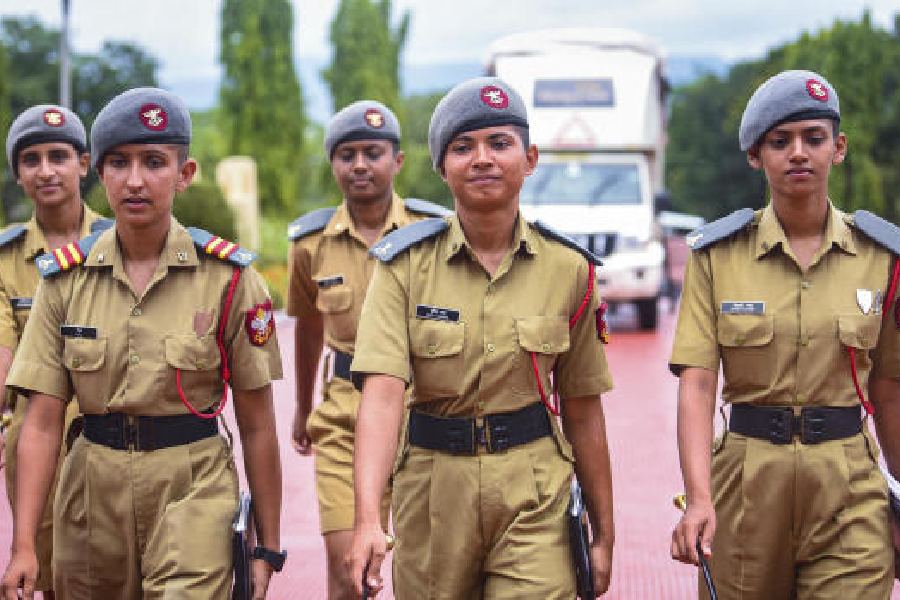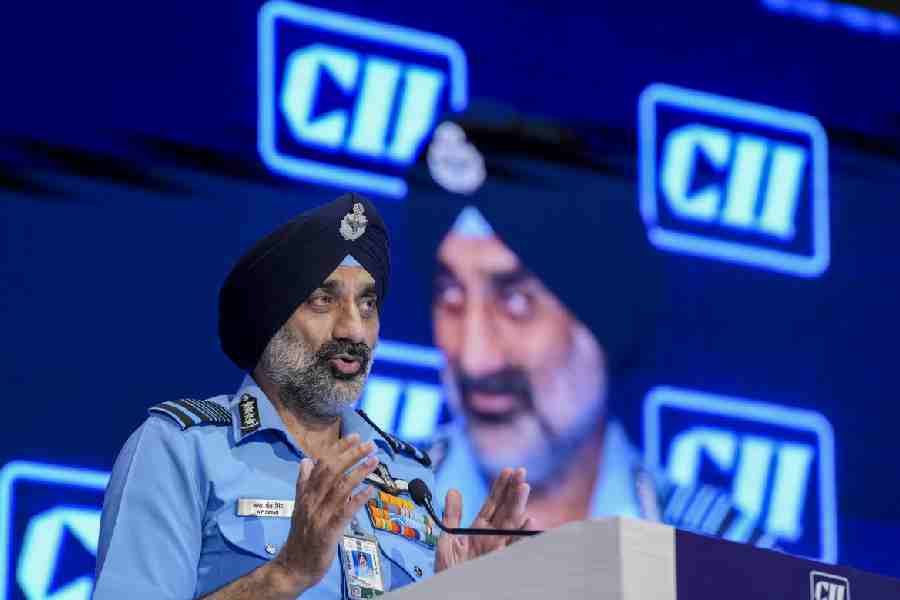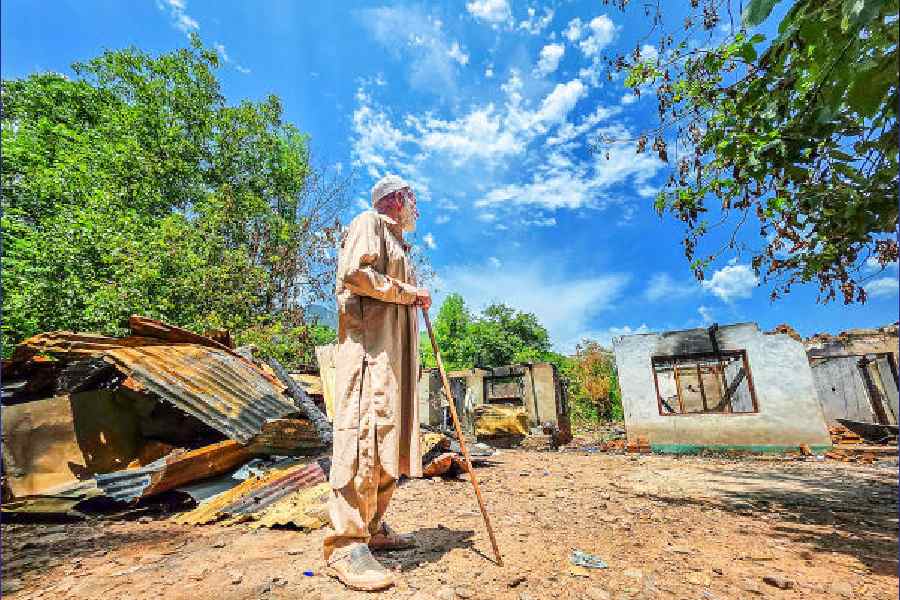 |  |
| (From left) Anant, Arun and Falguni Nevatia along with Anant’s son Shreyas, who also volunteers for RHCF, in a room in their home where they store medicines and (right) a queue of patients at the NGO’s Mayapur centre. Picture by Sanat Kumar Sinha | |
Finding the cure for diverse non life-threatening ailments is a challenge in rural Bengal. When you need to show a competent doctor, you need to bus miles; when you need access to medicines, the nearest retail outlet is a long distance away; when you need a rurally affordable means of recovery, the prescription could set you back a few hundred rupees.
There is hope. The one NGO that has successfully reversed this grim reality with one of the lowest costs of medical intermediation anywhere in the country is the Calcutta-based Rural Health Care Foundation.
What makes the story of the brothers Nevatia (Anant and Arun) and wife (Arun’s) Falguni interesting is that from a hypothetical perspective, there are more reasons why they could have failed. For one, the brothers could have continued to focus on growing their urban construction business and appointing a caretaker for their philanthropic interests, making such a hash of things that the operation could have remained an expense account. Besides, Arun, who was diagnosed with Hodgkin’s Disease at age 10, suffered three relapses and has leukaemia since 2008.
Rather than merely become more prosperous for private gain, the Nevatias resolved to become productive for public benefit. Prodded by the guilt of self-obsessed inaction, they responded un-entrepreneurially. They launched a 700sq ft centre in Mayapur with no terrain insight. They started a one-day clinic with eye, dental and general doctors without understanding whether the geography required it. They priced the not-for-profit service for Rs 5 per patient (diagnosis and seven days of medicines) without checking whether anyone would pay.
Enthusiasm prevailed. The brothers were provoked by the poverty of villagers who turned up from 3am onwards. The queue snaking across a kilometre. Each token being black-marketed for Rs 5. Attendees coming from across the Bangladesh border. Now it was izzat ka sawaal. The Nevatias couldn’t back out. So they religiously drove 140km every Friday morning week after week, spent three full days in the back of beyond, assisted doctors, managed the queues, attended to patients and returned Sunday night. Pooped. But satisfied.
Within 12 weeks of having transformed a skeletal service into a mini-success story, the Nevatias encountered their first hurdle. The landlord — fed on stories of how these ‘construction fellows’ would muscle in and take the place over — asked them to vacate. A new landlord moved them out in a week. New places were either too expensive or too small. Just when Anant said ‘Bahut hua samaaj seva, let us take the machines and get back to Calcutta’ a seller materialised and within a fortnight the flickering operation had been salvaged.
Anybody would have said well done boys, except the accountant. Every month, the Nevatias were down an incremental Rs 150,000. The bigger the queue, the higher the deficit. To plug the leak were three alternatives: restrict patients, strengthen funding or source better.
And this is where the canny Nevatias bought into play their rich business understanding. If they would not be the best funded NGO, they could at least be the most economical.
This is how: They would buy near-expiry branded medicines at a 90 per cent discount (a Rs 7 Pantaprazole-40 tablet would be acquired at 56 paise with long expiry and 17 paise with short expiry). They would buy generic medicines at two to 10 per cent of the cost of branded alternatives. The promoters worked from home to eliminate ‘office’ overheads. The on-site doctor would double up as the administrator. If they ventured to expand, they would do so within 100km of Calcutta to minimise material transfer costs. Discounts were limited to Rs 5 per person per hour (so only the genuine patients would wait eight hours for complete fee exemption). The promoters invested in online partaaccounting (attendances and receipts) to minimise site visits and related fuel costs.
This culture of austerity kick-started a virtuous cycle. Even as the brothers increased the service fee in five stages to Rs 40 per patient (against a cost of Rs 50), the patients did not decline. The two secrets: a wide 160 SKU range so that medicines were always available and no hidden costs.
It now became common knowledge among villagers that alternative service providers who attracted patients with a low entry load more than recouped the deficit through pharmacy commissions generated from a higher prescription load. On the other hand, Rural Health Care Foundation provided the patient with complete seven-day treatment coverage. Assured, more patients kept turning up from distant pockets. The Mayapur operation crossed its break-even point of 5,000 patients within 36 months of launch.
It is an interesting commentary on the state of Bengal’s public health care system that rural patients are willing to pay more upfront to a private not-for-profit initiative, generating adequate throughput and making it possible for two of RHCF’s five centres to become surplus-generating. RHCF’s ‘business’ model is sustainable; the surplus of one location is ploughed into fresh capex and the deficit of a new location until the latter turns around and the surplus of that centre can be ploughed into yet another centre across the Bengal landscape.
What started as a tentative one-day clinic at Mayapur in 2008 has extended to a six-day clinic at four additional locations (Namkhana, Kusumgram, Swarupnagar and Maltipur). What started as a brother-and-brother engagement has extended to Arun’s wife (who gave up a teaching career at Birla High School to concentrate full time) and their school-cum-college friends joining hands to form Rural Health Care Foundation. What started with a handful of assistants has now extended to 50 full-time employees (with PF and ESI compliances). What started as a miniscule one table outlet has emerged as a national model for reliable cost-effective medical intermediation endorsed by the IIMs (Bangalore and Calcutta) and recognised with the Mahindra Spark Award for Social Enterprise in 2012.
And yes, Arun who was given only six months to live in 2008 consumes the generic imatinib myselate for Rs 3000 against a branded cost of 100,000. Getting a taste of his own medicine. In more senses than most people would care to think.
The Nevatias can be reached at rhcf2009@gmail.com
Mudar Patherya heads Trisys and can be reached at mudar@trisyscom.com










